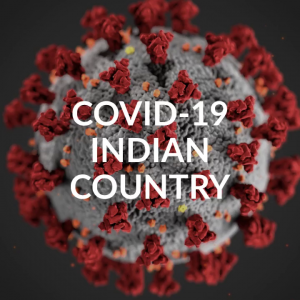 The Indian Health Service has updated its coronavirus data, showing results through December 4, 2022.
The Indian Health Service has updated its coronavirus data, showing results through December 4, 2022.
According to the data, 557,777 tests have returned positive for COVID-19, the disease caused by the coronavirus.
On July 24, the IHS reached a milestone. According to the results, over a half-million IHS patients have tested positive for COVID-19 since the onset of the pandemic in Indian Country more than two years ago.
Based on the IHS service population of 2,562,290 from 2019, the figure means that 21.8 percent of American Indians and Alaska Natives have been positive for the coronavirus.
Based on the IHS user population of 1,662,834, 33.5 percent have tested positive. The user population is defined as the number of American Indians and Alaska Natives who have lived within a service delivery area and have received health care at an IHS or tribal facility during the previous three years.
Altogether, 5,004,436 coronavirus tests have been administered within the IHS, the results show. The number of tests surpassed 5 million on December 4, according to the data.
Since mid-October of 2020, the IHS has been providing additional information about the spread of the coronavirus within the system. The cumulative percent positive column shows the historical COVID-19 infection rate, meaning the number of tests that have returned positive since the onset of the pandemic.
Based on the cumulative percent positive, the highest rates have been seen in five of 12 IHS areas. Two of them include the state of Arizona, indicating a disproportionate toll of COVID-19 in the state:
- Navajo Area — 17.3 percent
- Phoenix Area — 15.4 percent
- Oklahoma City Area — 15.2 percent
- California Area — 12.0 percent
- Albuquerque Area — 11.0 percent
The Phoenix Area has overtaken the Oklahoma City Area as the region with the second highest percentage of cumulative percent positive tests. Still, the two regions have virtually the same cumulative positivity rate as of December 4.
The 7-day rolling average positivity column offers a more contemporary look at the impact of the coronavirus. The data shows where COVID-19 cases have been increasing recently in the 12 areas of the IHS.
- Navajo Area — 19.8 percent
- Phoenix Area — 18.1 percent
- Portland Area — 13.9 percent
- Nashville Area — 12.6 percent
- California Area — 12.5 percent
- Oklahoma City Area — 9.5 percent
- Billings Area — 8.2 percent
- Great Plains Area — 6.7 percent
- Bemidji Area — 5.4 percent
- Albuquerque Area — 3.6 percent
- Alaska Area — 3.1 percent
- Tucson Area — 0.0 percent
Overall, 11.8 percent of IHS tests have been positive since the onset of the pandemic, the data shows. Meanwhile, the 7-day positivity rate has dropped significantly, following record highs after the Christmas 2021 holiday. However, it has been rising in recent weeks and it now stands at 12.5 percent.
The data, however, is incomplete. While 100 percent of facilities run directly by the IHS are reporting data, only 33 percent of tribally managed facilities and 44 percent of urban Indian organizations are doing the same, the agency has told Indianz.Com.
Beginning June 7, 2021, the IHS began updating its coronavirus data on a weekly basis. But as the number of COVID-19 cases grows again, the agency is updating results twice a week — usually on Mondays and Thursdays. Throughout 2020 and the first half of 2021, results were provided by the IHS every day.
COVID-19 Cases by IHS Area
Data are reported from IHS, tribal, and urban Indian organization facilities, though reporting by tribal and urban programs is voluntary. Data reflect cases reported to the IHS through 11:59 pm on Dec 4, 2022.
|
IHS Area
|
Tested
|
Positive
|
Negative
|
Cumulative
percent
positive
|
7-day rolling
average
positivity
|
|---|---|---|---|---|---|
| Alaska | 1,124,885 | 55,995 | 918,957 | 5.7% | 3.1% |
| Albuquerque | 182,284 | 17,354 | 140,912 | 11.0% | 3.6% |
| Bemidji | 325,048 | 33,830 | 289,677 | 10.5% | 5.4% |
| Billings | 161,903 | 14,300 | 142,696 | 9.1% | 8.2% |
| California | 203,158 | 23,269 | 169,874 | 12.0% | 12.5% |
| Great Plains | 302,887 | 32,887 | 266,141 | 11.0% | 6.7% |
| Nashville | 201,364 | 21,839 | 169,138 | 11.4% | 12.6% |
| Navajo | 589,157 | 88,257 | 423,007 | 17.3% | 19.8% |
| Oklahoma | 1,237,444 | 186,503 | 1,039,640 | 15.2% | 9.5% |
| Phoenix | 335,730 | 51,297 | 281,882 | 15.4% | 18.1% |
| Portland | 256,279 | 22,678 | 232,988 | 8.9% | 13.9% |
| Tucson | 84,297 | 9,568 | 74,449 | 11.4% | 0.0% |
| TOTAL | 5,004,436 | 557,777 | 4,149,361 | 11.8% | 12.5% |
COVID-19 testing data is updated on Mondays and Thursdays by 5 pm ET.
Data Source: Indian Health Service (https://www.ihs.gov/coronavirus)
Indian Health Service Announces New Deputy Director for Quality Health Care and Enterprise Risk Management (Indian Health Service)
Federal Emergency Management Agency (FEMA)
White House Office of Management and Budget (Joe Biden Administration)
Tuba City Regional Health Care Corporation (Arizona, Navajo Nation)
Oklahoma City Indian Clinic (OKCIC)
Indian Health Service (Department of Health and Human Services)
Navajo Nation Town Hall (Arizona, New Mexico, Utah)
Navajo Nation (Arizona, New Mexico, Utah)
Tribal organizations statement on advance appropriations for Indian Health Service
Indian Health Service Statement on Advance Appropriations (Department of Health and Human Services)
Indian Health Service (Department of Health and Human Services)
Indian Health Service (Department of Health and Human Services)
Navajo Nation (Arizona, New Mexico, Utah)
Indian Health Service (Department of Health and Human Services)
